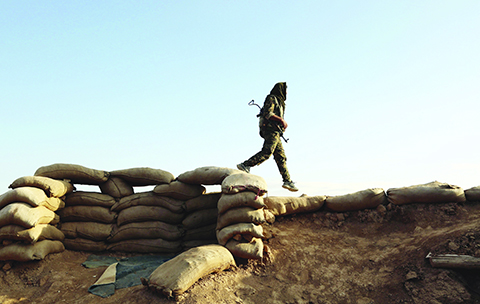BEIRUT: Activists accused the Islamic State (IS) group yesterday of being behind a deadly gas attack in northern Syria this past summer, which the global chemical weapons watchdog said was mustard gas. Meanwhile, Islamist rebels wrested back a flashpoint town in the central province of Hama, reversing the last of gains the army had made in a month-old offensive.
Mustard gas was used in the town of Marea in Aleppo province on August 21, a source from the Organisation for the Prohibition for the Prohibition of Chemical Weapons said. "We have determined the facts, but we have not determined who was responsible," the source said. But activists and a monitoring group said it was clear that IS was behind the attack.
Rami Abdel Rahman, head of the Syrian Observatory for Human Rights monitoring group, said "IS used toxic gases during its attack on Marea in August." He said IS had likely gotten the gas through Turkey or Iraq. Journalist Maamun Al-Khatib, who was in Marea at the time, said: "We knew it was IS because all the shells were being fired east of Marea, and that area is totally under the control of IS."
IS has attacked Marea for months in an effort to cut off a supply route into the country from Turkey. For activist Nizar Al-Khatib, OPCW's report "comes too late and isn't enough, because it doesn't identify IS as the one responsible for firing the mustard gas."
Rebels roll back
Doctors Without Borders (MSF), which operated a nearby field clinic, treated four members of a single family for "symptoms of exposure to chemical agents." The Marea residents told MSF they saw a "yellow gas" when a mortar round hit their house.
An MSF spokesman said yesterday that the Paris-based group did not have enough evidence to finger IS. After a chemical attack that killed hundreds in the Eastern Ghouta region east of Damascus in August 2013, Syria agreed to declare and hand over its chemical weapons in a deal overseen by OPCW. Meanwhile, Islamist fighters including Ahrar Al-Sham seized a town in Hama province, rolling back a series of recent gains by the beleaguered armed forces of Damascus.
Ahrar Al-Sham and allied rebels overran Atshan and nearby villages in the morning and, despite Russian air support, the army was unable to push them back, the Observatory said. Russian warplanes had been key to the army's gains in the offensive it launched in Hama on October 7, one of several ground assaults across Syria backed by Moscow.
The government captured Atshan on October 10, but withdrew from it and nearby towns, including Umm Al-Haratayn, yesterday. "Regime forces lost control of the last remaining towns it had seized since the beginning of its ground operations in the northern parts of Hama province," Observatory chief Rami Abdel Rahman said.
TOWS against tanks
The setback comes a day after the army lost the towns of Morek and Tal Skeik to jihadists and other rebels. The loss of Morek cost the army the last town under its control along the main highway north from Hama to second city Aleppo. Morek has changed hands several times in Syria's four-year civil war.
Government troops last retook it in October 2014. The army still controls swathes of territory south of the town but is facing a fierce fightback from rebels using US-made TOW anti-tank missiles. According to the Revolutionary Forces of Syria Media office, which publishes news on opposition military developments, rebel groups across Syria destroyed at least 123 army tanks in October alone using TOW missiles. More than 250,000 people have died in Syria's conflict, which several rounds of diplomatic pushes have failed to end. - AFP










